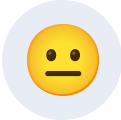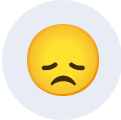StoreSEO hilft Optimieren Sie Shopify-Seiten für SEO damit sie bei Ihren potenziellen Kunden online besser sichtbar sind. StoreSEO stellt sicher, dass alles in Ordnung ist, indem es einen SEO-Score und alle Probleme anzeigt, die behoben werden müssen, um einen guten SEO-Score für Ihre Shopify-Seite zu erzielen. Diese Dokumentation behandelt all dies.
Bevor Sie beginnen, stellen Sie sicher, dass Sie eine Shopify-Seite hinzugefügt haben und installierte StoreSEO App auf Ihrem Shopify Store. Befolgen Sie dann diese Schritt-für-Schritt-Anleitung, um herauszufinden, wie Sie die Seite mit StoreSEO optimieren können.
Schritt 1: Navigieren Sie zur StoreSEO-Seitenoptimierung #
Melden Sie sich bei Ihrem Shopify-Shop an. Wählen Sie dann in der Suchleiste oben oder im MenüApps' in der linken Seitenleiste, suchen Sie nach der StoreSEO-App und klicken Sie darauf. Gehen Sie im StoreSEO-Dashboard zu 'SEO optimierenKlicken Sie nun auf die Registerkarte 'Seiten'-Option.
Sobald Ihre Seiten richtig synchronisiert sind, sehen Sie Ihre Seitenliste. Wählen Sie die Seite aus, die Sie optimieren möchten, und klicken Sie auf 'Problem beheben' Taste.
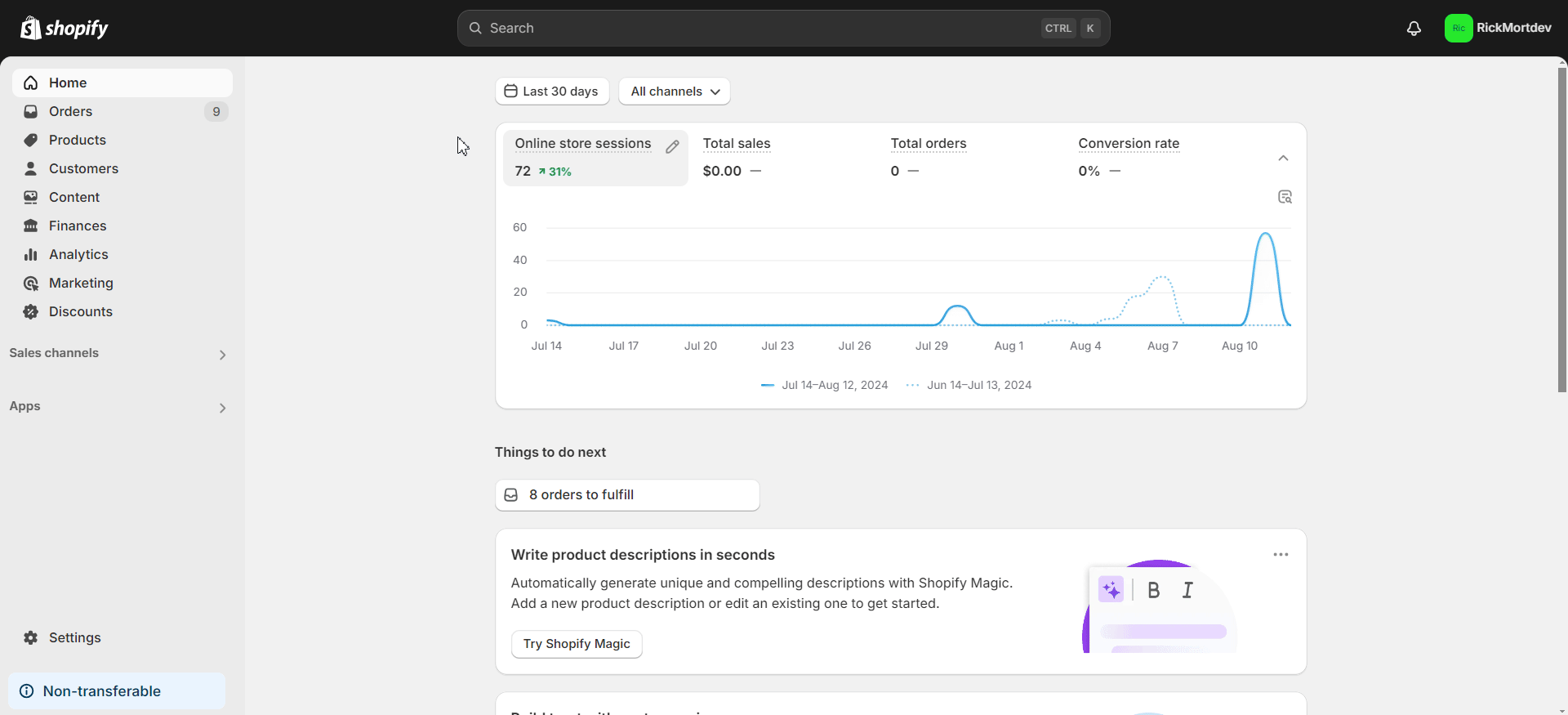
Schritt 2: Optimieren Sie Ihre Seite auf Shopify #
Jetzt ist es an der Zeit, die SEO für Shopify-Seiten. Wie Sie im Bild unten sehen können, werden die SEO-Details Ihrer ausgewählten Seite von StoreSEO angezeigt. Auf der rechten Seite finden Sie außerdem Grundlegende SEO-Analyse Und Detaillierte SEO-Analyse um die Schlüsselfaktoren zu finden, die angegangen werden müssen, um den SEO-Score zu verbessern.
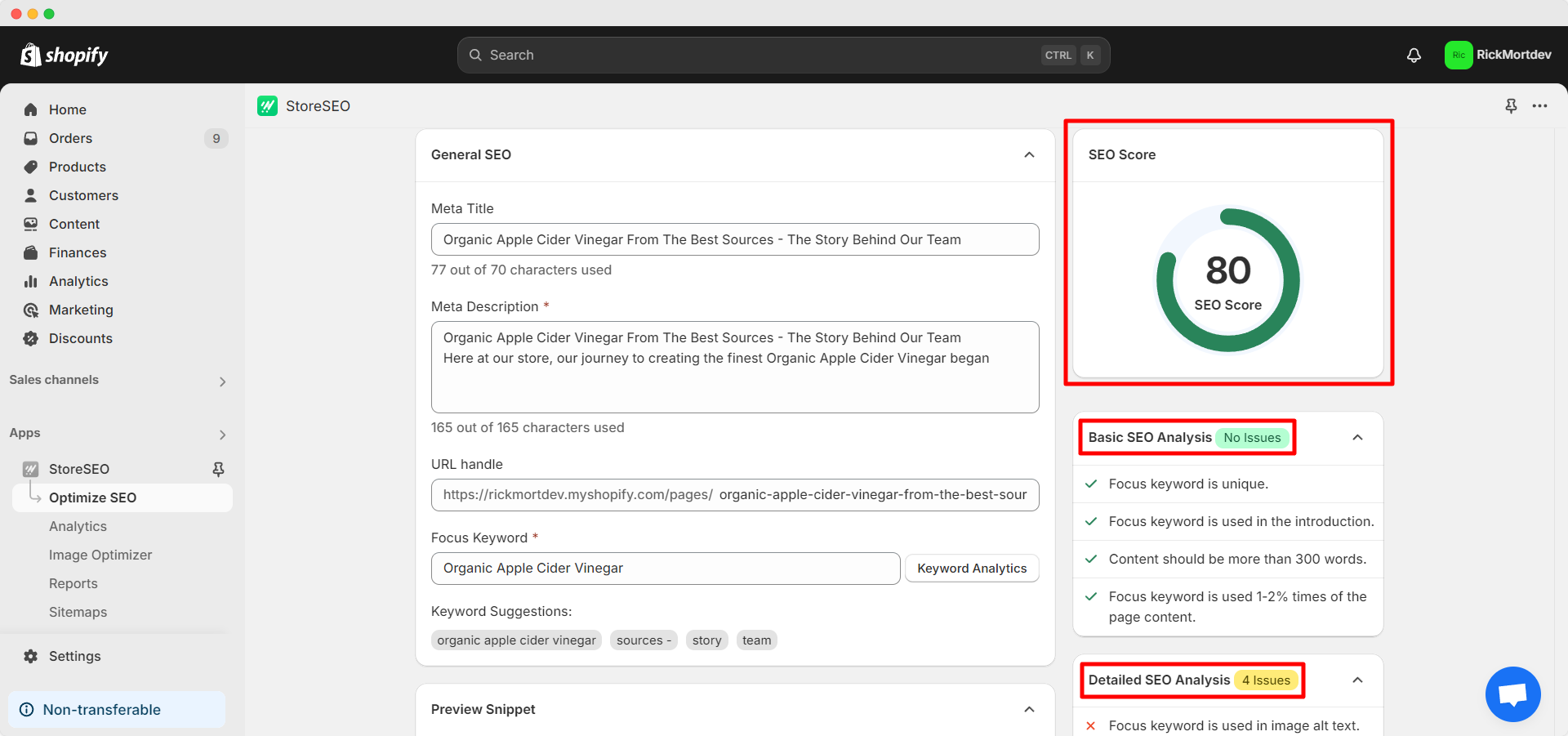
Grundlegende SEO-Analyse #
Beginnen wir mit Grundlegende SEO-Analyse. Dabei müssen wir verschiedene Kriterien sicherstellen, wie z. B. die Platzierung eines einzigartigen Fokus-Keywords in der Einleitung, die Einhaltung einer idealen Fokus-Keyword-Frequenz und die Erfüllung einiger weiterer Anforderungen. Wir zeigen Ihnen nun, wie Sie diese nacheinander erreichen.
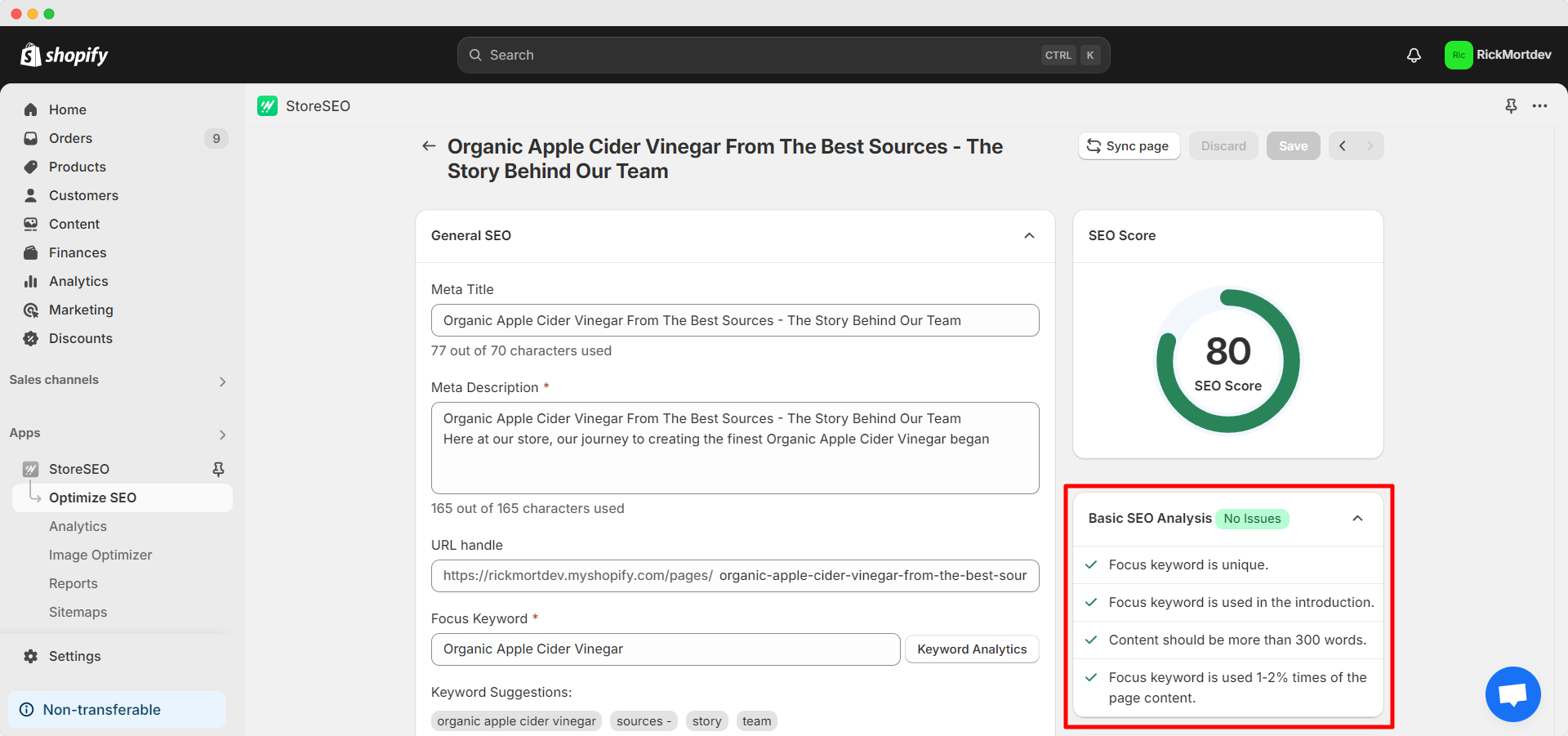
Das Fokus-Keyword ist eindeutig #
Zuerst müssen Sie Wählen Sie das richtige Fokus-Keyword. Dies ist entscheidend, da die Seite in Suchmaschinen anhand dieses Schlüsselworts indexiert wird. Einfach ausgedrückt: Ihre potenziellen Besucher haben eine höhere Wahrscheinlichkeit, Ihre Seite zu finden, wenn ihr Suchbegriff und Ihr ausgewähltes Fokus-Schlüsselwort übereinstimmen.
Deshalb müssen Sie sehr vorsichtig sein und die richtige Keyword-Recherche bei der Auswahl des Fokus-Keywords. Hier sind einige Dinge, die Sie beachten sollten:
Keyword-Relevanz: Stellen Sie sicher, dass das Schlüsselwort für das Thema Ihrer Seite, Ihr Unternehmen, Ihre Zielgruppe und Ihre Nische relevant ist. Angenommen, Sie verkaufen Apfelessig. Ihr Fokusschlüsselwort sollte für dieses Produkt relevant sein. Nun wählen Sie ein Schlüsselwort mit hohem Suchvolumen aus, das den Begriff „Apple iPhone' oder 'Apfelsaft'. Diese Schlüsselwörter liegen außerhalb Ihrer Produktnische. Obwohl sie also möglicherweise ein höheres Suchvolumen aufweisen, sind sie keine relevante Option.
Suchvolumen: Schlüsselwörter mit höherem Suchvolumen werden jeden Monat häufiger gesucht. Wenn Sie Schlüsselwörter mit höherem Suchvolumen auswählen, ist die Wahrscheinlichkeit höher, dass Sie mit mehr Konkurrenz konfrontiert werden. Je spezifischer die Schlüsselwörter sind, die Sie verwenden, desto präziser können Sie Ihre Zielgruppe erreichen.
Wenn Sie nun ein langes Fokus-Keyword wie „original ungefilterter Bio-Apfelessig', Sie haben ein einzigartiges Schlüsselwort, aber es besteht eine geringere Wahrscheinlichkeit, dass Kunden dieses gesamte Schlüsselwort bei einer Suche verwenden. Aus diesem Grund hat es kein gutes Suchvolumen, wie im Bild unten gezeigt.
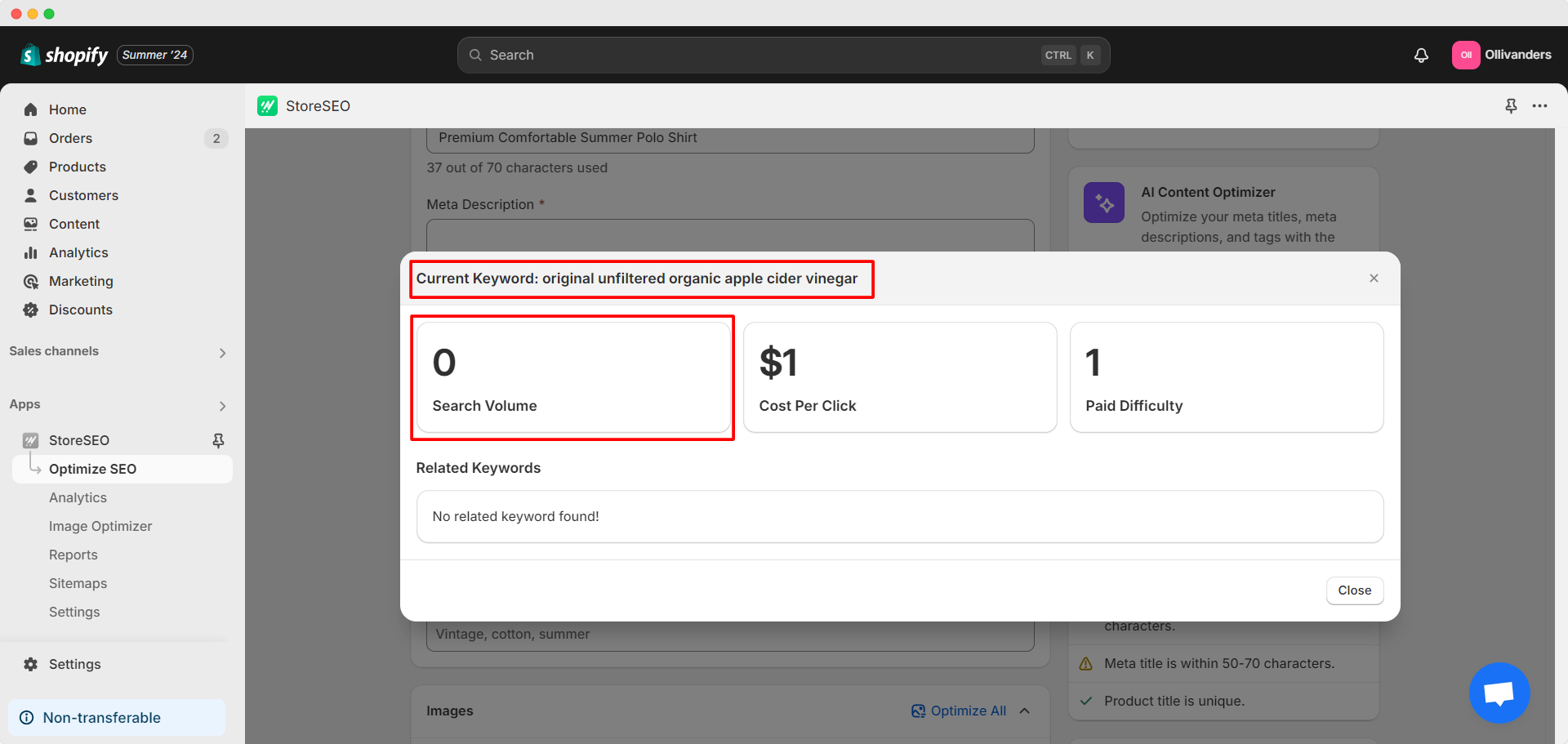
Wenn Sie nun ein kurzes Fokus-Keyword wie 'Apfelessig', werden Sie feststellen, dass es ein hohes Suchvolumen hat, wie im Bild unten gezeigt. Solche beliebten Schlüsselwörter haben jedoch zu viel Verkehr und es wird viel schwieriger sein, ein Ranking zu erzielen und Ihr Publikum zu erreichen.
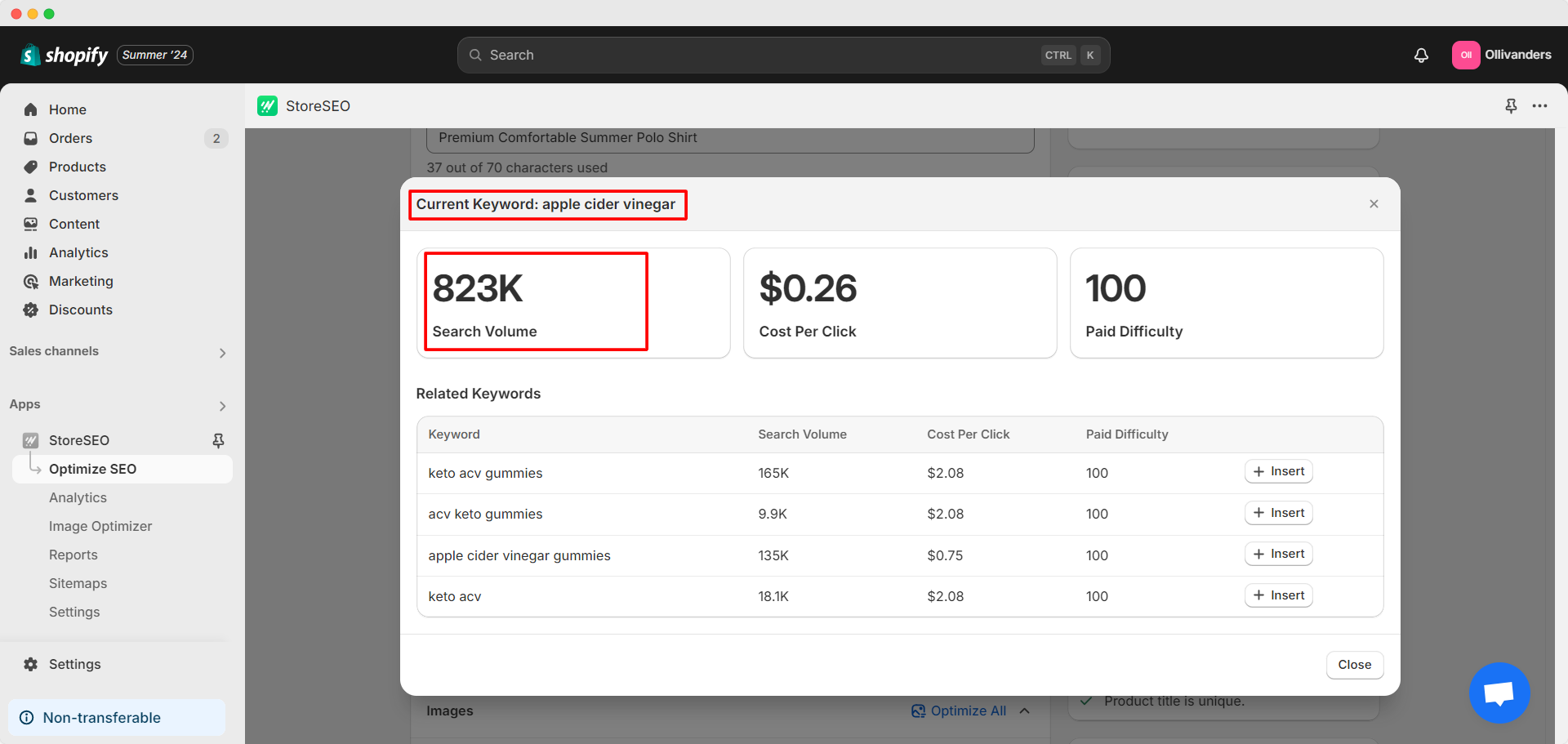
Wenn Sie dagegen das Fokus-Keyword 'Bio-Apfelessig', Sie haben ein gutes Suchvolumen (nicht zu hoch) und es besteht eine höhere Wahrscheinlichkeit, ohne große Konkurrenz indiziert zu werden. Deshalb ist dies in diesem speziellen Fall die geeignetere Fokus-Keyword-Option.
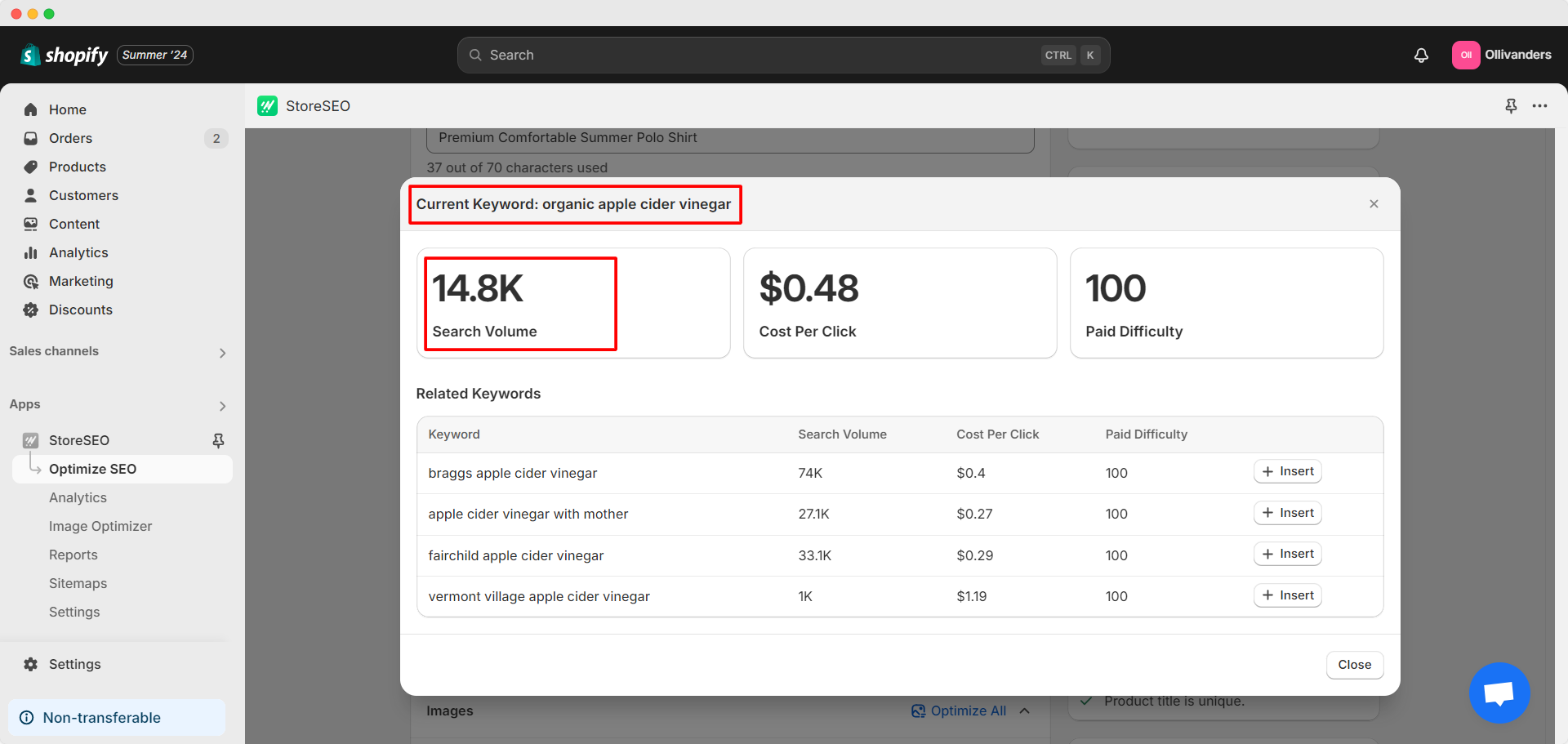
Kosten pro Klick: Wenn Sie Anzeigen mit bestimmten Schlüsselwörtern schalten, bestimmt der Preis pro Klick das ungefähre Budget für die Werbekampagne. Wenn Sie also Schlüsselwörter mit einem höheren Preis pro Klick wählen, bedeutet dies, dass Sie ein größeres Kampagnenbudget benötigen. Bitte beachten Sie, dass es sich um einen geschätzten Wert handelt und Sie müssen sich keine Sorgen machen, wenn Sie keine Werbung schalten.
Bezahlter Schwierigkeitsgrad: Dies stellt die Nachfrage nach Schlüsselwörtern dar, wenn sie in bezahlten Anzeigen verwendet werden. Eine höhere bezahlte Schwierigkeit weist darauf hin, dass das Schlüsselwort auch bei der organischen Suche mehr Konkurrenz hat. Es ist also eine wichtige Kennzahl bei der Schlüsselwortrecherche.
Verwandte Stichwörter: Denken Sie daran, die verwandten Schlüsselwörter für ein bestimmtes Schlüsselwort zu prüfen. Diese verwandten Schlüsselwörter geben Ihnen zusätzliche Schlüsselwortvorschläge. So stoßen Sie möglicherweise auf eine bessere Fokus-Schlüsselwortoption. Stellen Sie sicher, dass die verwandten Schlüsselwörter zu Ihrem Produkt, Ihrem Unternehmen, Ihrer Zielgruppe und Ihrer Nische passen.
Zurück zur Seitenoptimierung auf StoreSEO, platzieren Sie Ihr bevorzugtes Schlüsselwort im 'Fokus KeywordKlicken Sie auf das Feld 'Keyword-Analyse'-Taste, um sofort die Suchvolumen, Kosten pro Klick, Bezahlter Schwierigkeitsgrad Und Verwandte Stichwörter für Ihr Schlüsselwort.
Hier haben wir ausgewählt 'Bio-Apfelessig' als Fokusschlüsselwort. Es wird empfohlen, für verschiedene Seiten unterschiedliche Fokusschlüsselwörter zu verwenden. Wählen Sie ein Schlüsselwort entsprechend Ihrem Unternehmen und dem Seitenthema. Keyword-Recherche für Shopify dafür.
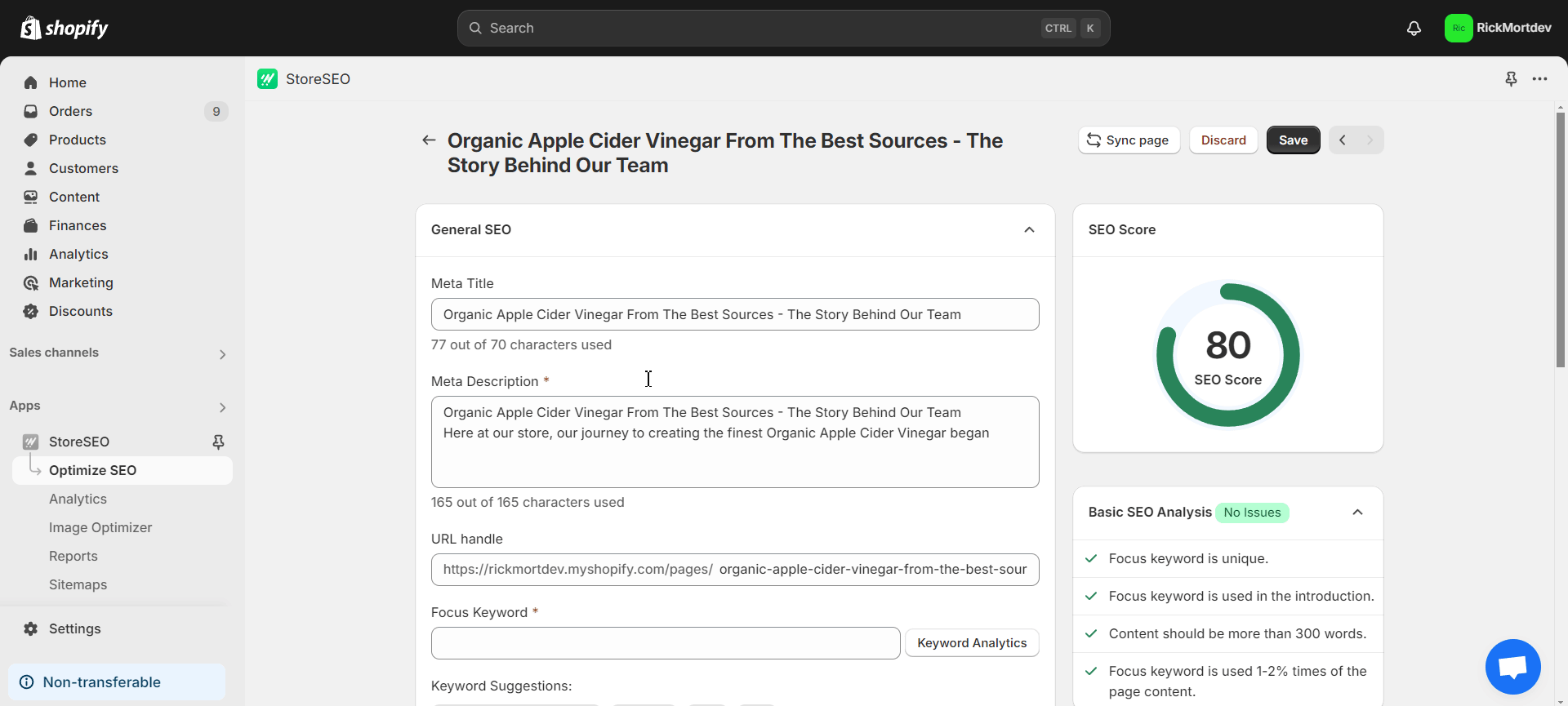
Das Fokus-Keyword wird in der Einleitung verwendet #
Stellen Sie als Nächstes sicher, dass das Fokus-Keyword in der Einleitung der Shopify-Seite verwendet wird. Um Ihre Seite zu bearbeiten, navigieren Sie zu Vertriebskanälen im linken Seitenbereich Ihres Shopify-Dashboards. Wählen Sie dann „Online-Shop' und klicken Sie auf die 'Seiten'. Wählen Sie die Seite aus, die Sie bearbeiten möchten. Achten Sie darauf, das Fokus-Keyword in der Einleitung zu platzieren. Wie Sie im Bild unten sehen können, enthält die Einleitung unserer Shopify-Seite 'Bio-Apfelessig' oder unser ausgewähltes Fokus-Keyword.
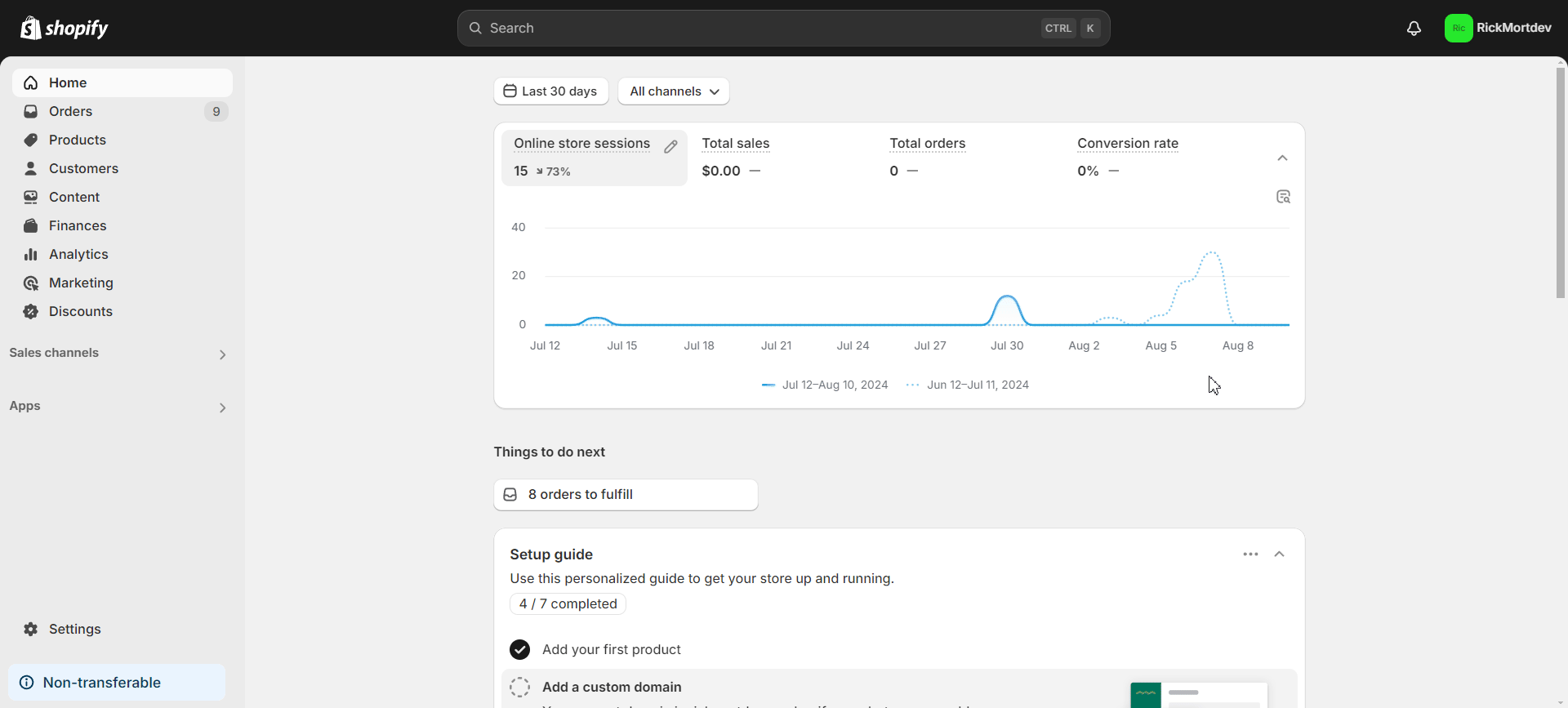
Der Inhalt sollte mehr als 300 Wörter umfassen #
Fügen Sie mehr als 300 Wörter in den Seiteninhalt ein, um den SEO-Score weiter zu optimieren. Stellen Sie sicher, dass Ihr Seiteninhalt mehr als 300 Wörter enthält und gleichzeitig Relevanz und Aussagekraft beibehält, wie im Bild unten gezeigt.
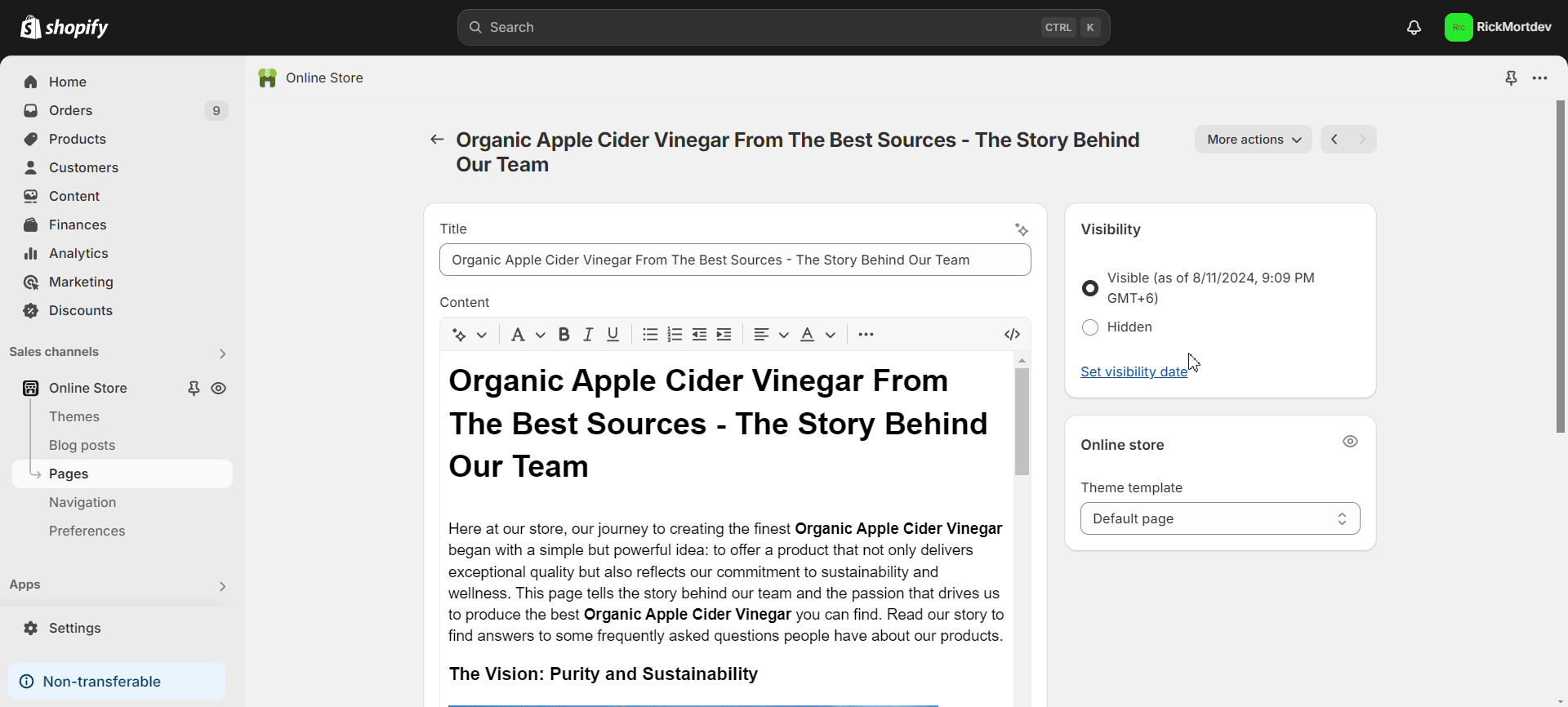
Das Fokus-Keyword wird 1-2% Mal im Seiteninhalt verwendet #
Ihr Fokus-Keyword sollte 1-2% Mal im Seiteninhalt verwendet werden. Vermeiden Sie jedoch Keyword-Stuffing oder die Platzierung des Keywords aufdringlich oder unnatürlich. Wie Sie im Bild unten sehen können, haben wir unser ausgewähltes Fokus-Keyword platziert, um die oben genannte ideale Häufigkeit beizubehalten.
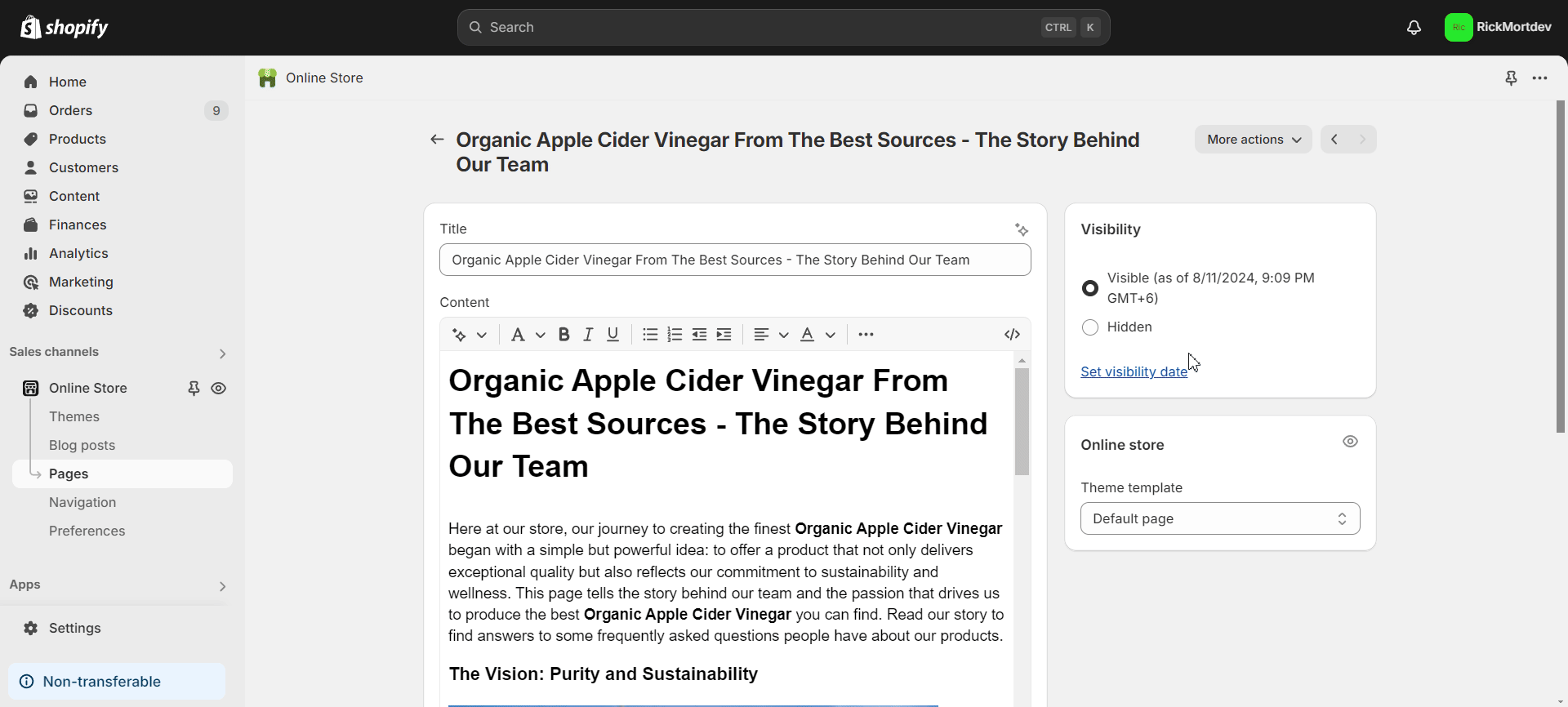
Detaillierte SEO-Analyse #
Wir werden nun fortfahren mit Detaillierte SEO-Analyse. Dafür müssen wir sicherstellen, dass das Fokus-Keyword im Alternativtext des Bildes, in den Unterüberschriften, in der Meta-Beschreibung und in der URL platziert wird und einige weitere Anforderungen erfüllt sind. Wir zeigen Ihnen, wie das alles geht.
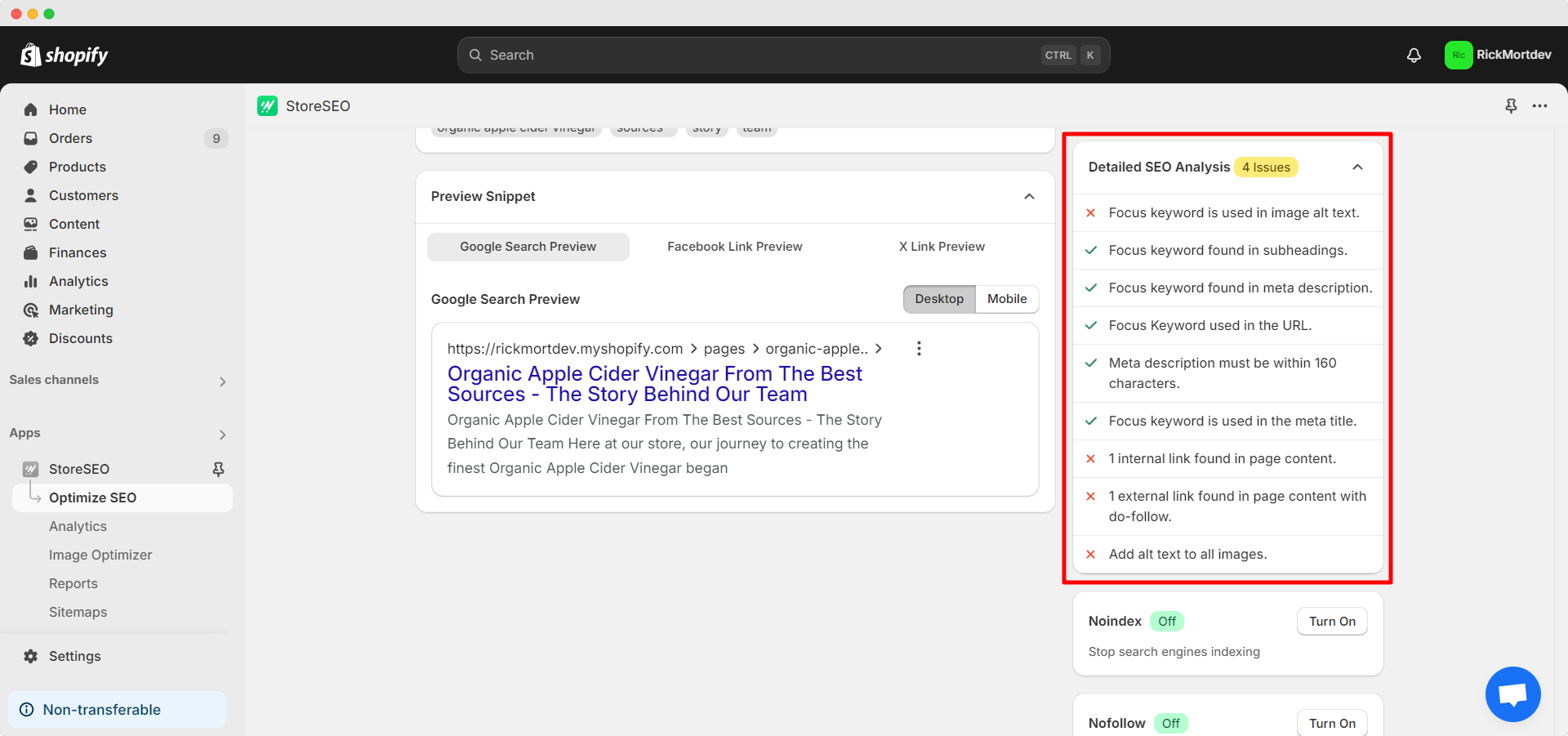
Das Fokus-Schlüsselwort wird im Alternativtext des Bildes verwendet #
Stellen Sie sicher, dass das Fokus-Schlüsselwort verwendet wird, wenn Sie den Bildern Ihrer Shopify-Seite Alternativtext hinzufügen. Doppelklicken Sie dazu beim Bearbeiten Ihrer Shopify-Seite auf das Bild. Stellen Sie dann sicher, dass das Fokus-Schlüsselwort in „Alternativtext des BildesKlicken Sie auf das Feld 'Bild bearbeiten', um alle Änderungen zu speichern.
Wie Sie im Bild unten sehen können, ist das Bild-Alt-Textfeld „Bio-Apfelessig „Aus den besten Quellen – Die Geschichte hinter unserem Team“ enthält unser ausgewähltes Fokus-Keyword (fett markiert).
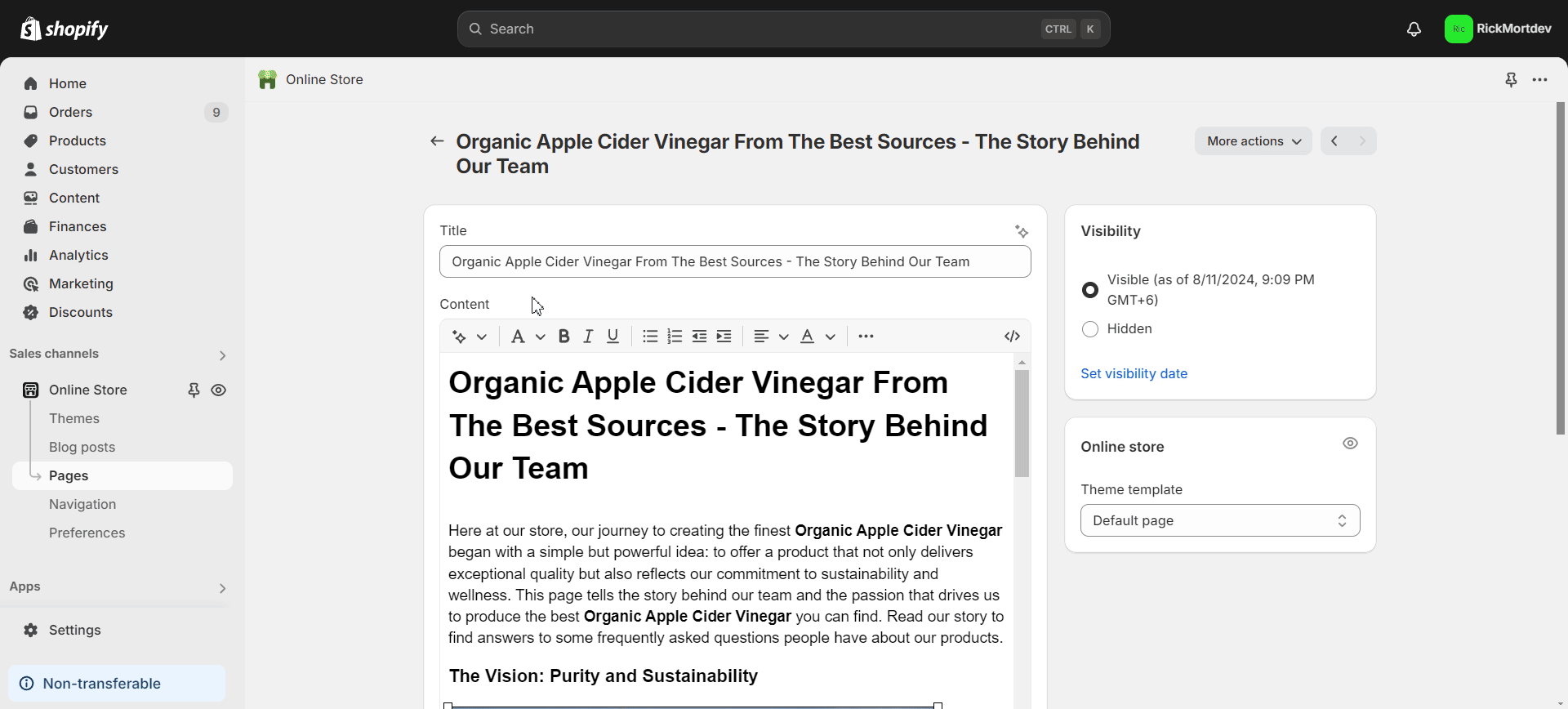
Fokus-Keyword in Unterüberschriften gefunden #
Stellen Sie sicher, dass die Unterüberschriften Ihrer Seite das Fokus-Schlüsselwort enthalten. Sie können dies Ihrer Unterüberschrift hinzufügen, wenn Sie Ihre Seite wie zuvor beschrieben über das Shopify-Dashboard bearbeiten. Wie Sie im Bild unten sehen können, ist unsere Unterüberschrift „Das Handwerk des Herstellens Bio-Apfelessig' enthält unser ausgewähltes Fokus-Keyword (fett markiert).
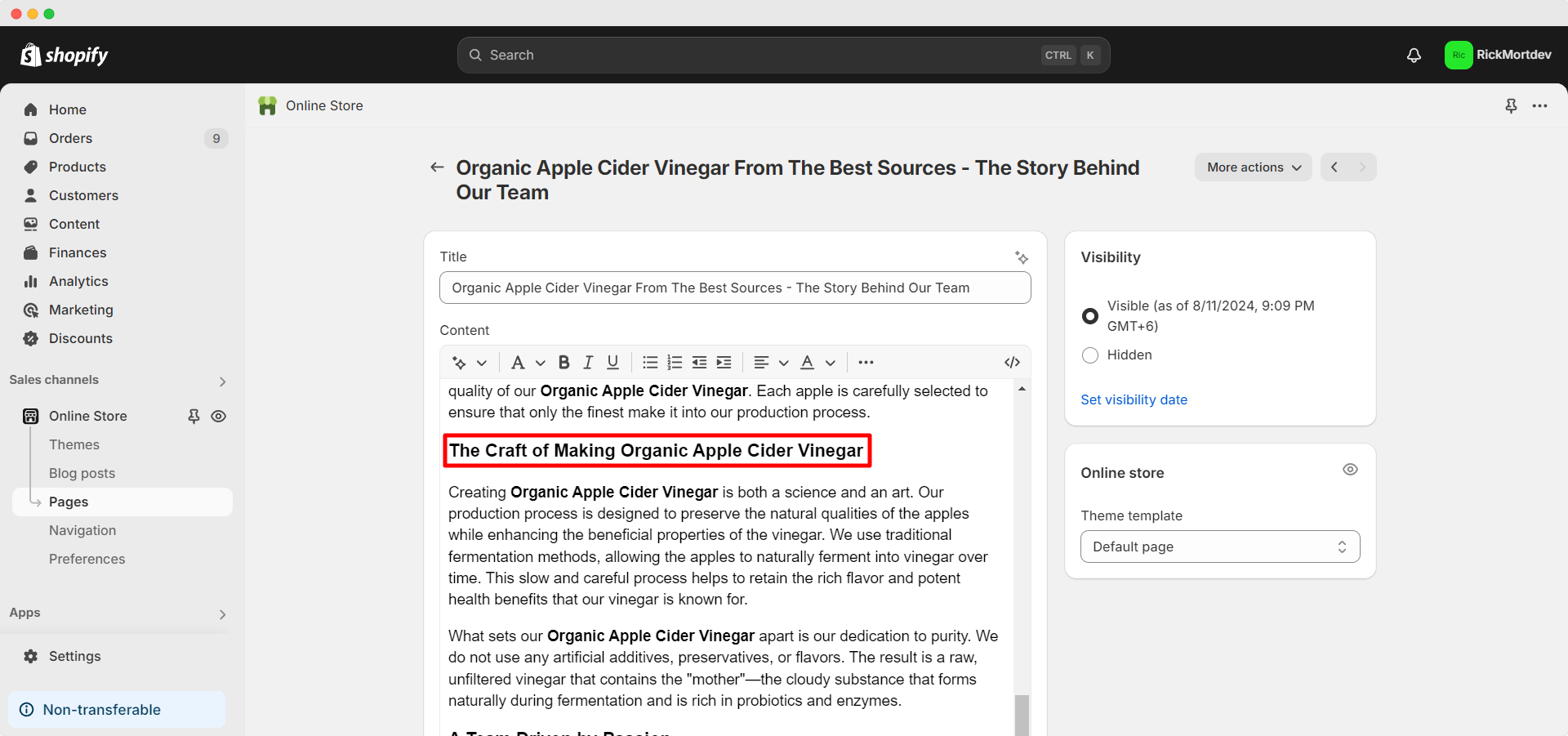
Fokus-Keyword in Meta-Beschreibung gefunden #
Ihre Meta-Beschreibung sollte Ihr ausgewähltes Fokus-Keyword enthalten. Über die StoreSEO-Seitenoptimierung können Sie das Fokus-Keyword in das Feld Meta-Beschreibung einfügen. Unsere Meta-Beschreibung lautet wie folgt:
Entdecken Sie die Geschichte hinter unserem Bio-ApfelessigErfahren Sie, wie unser Team sicherstellt, dass Sie nur die besten Produkte aus den reinsten Quellen zu den besten Preisen erhalten.
Es enthält also unser ausgewähltes Fokus-Keyword (fett markiert)
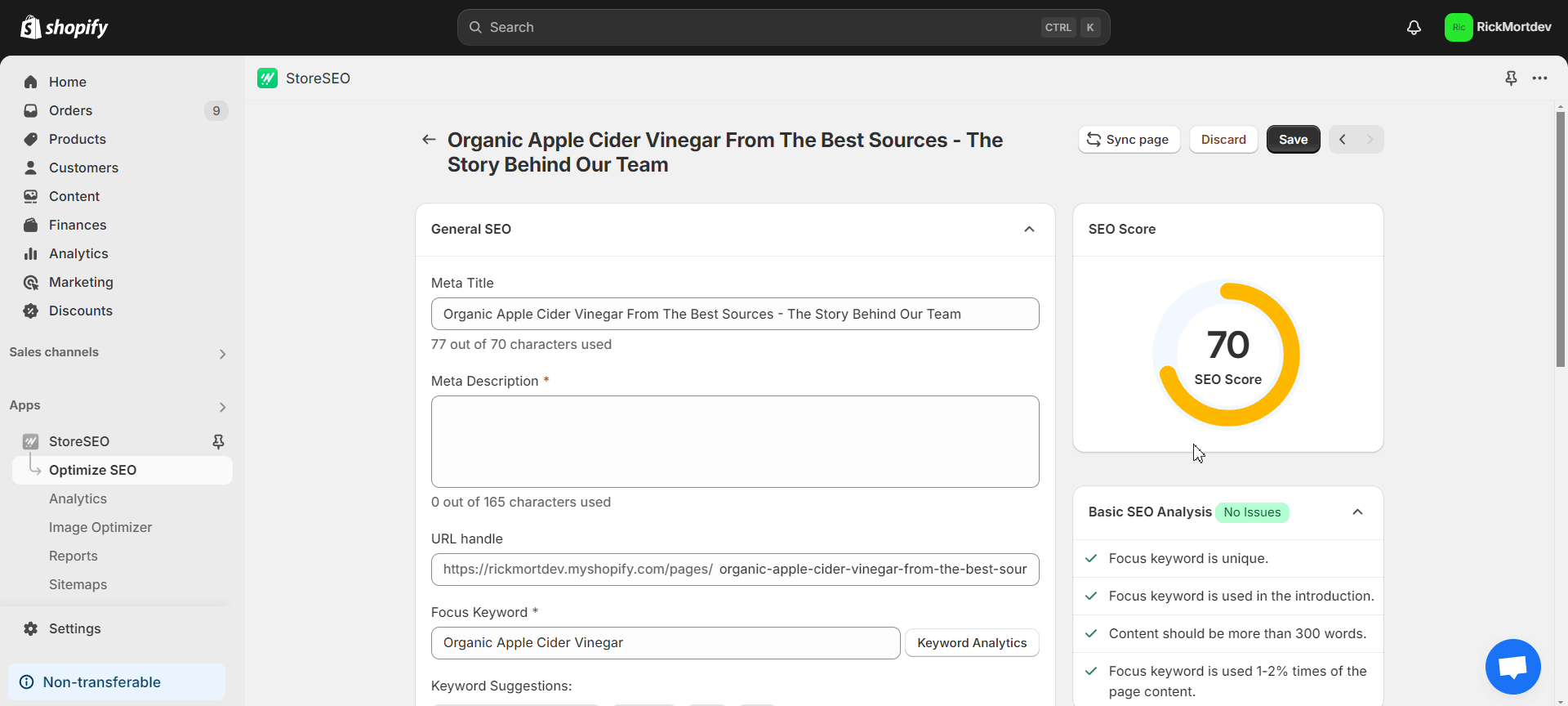
In der URL verwendetes Fokus-Keyword #
Stellen Sie sicher, dass die Shopify-Seiten-URL das Fokus-Keyword enthält. Sie können die URL unter „URL-Handle'-Feld, wenn Sie Ihre Seite mit StoreSEO optimieren. Wie Sie sehen, enthält das URL-Feld 'Bio-Apfelessig' oder unser ausgewähltes Fokus-Keyword.
Notiz: Wenn Ihre Seite bereits indexiert wurde und Sie die URL ändern möchten, empfiehlt es sich, Erstellen Sie eine URL-Umleitung.
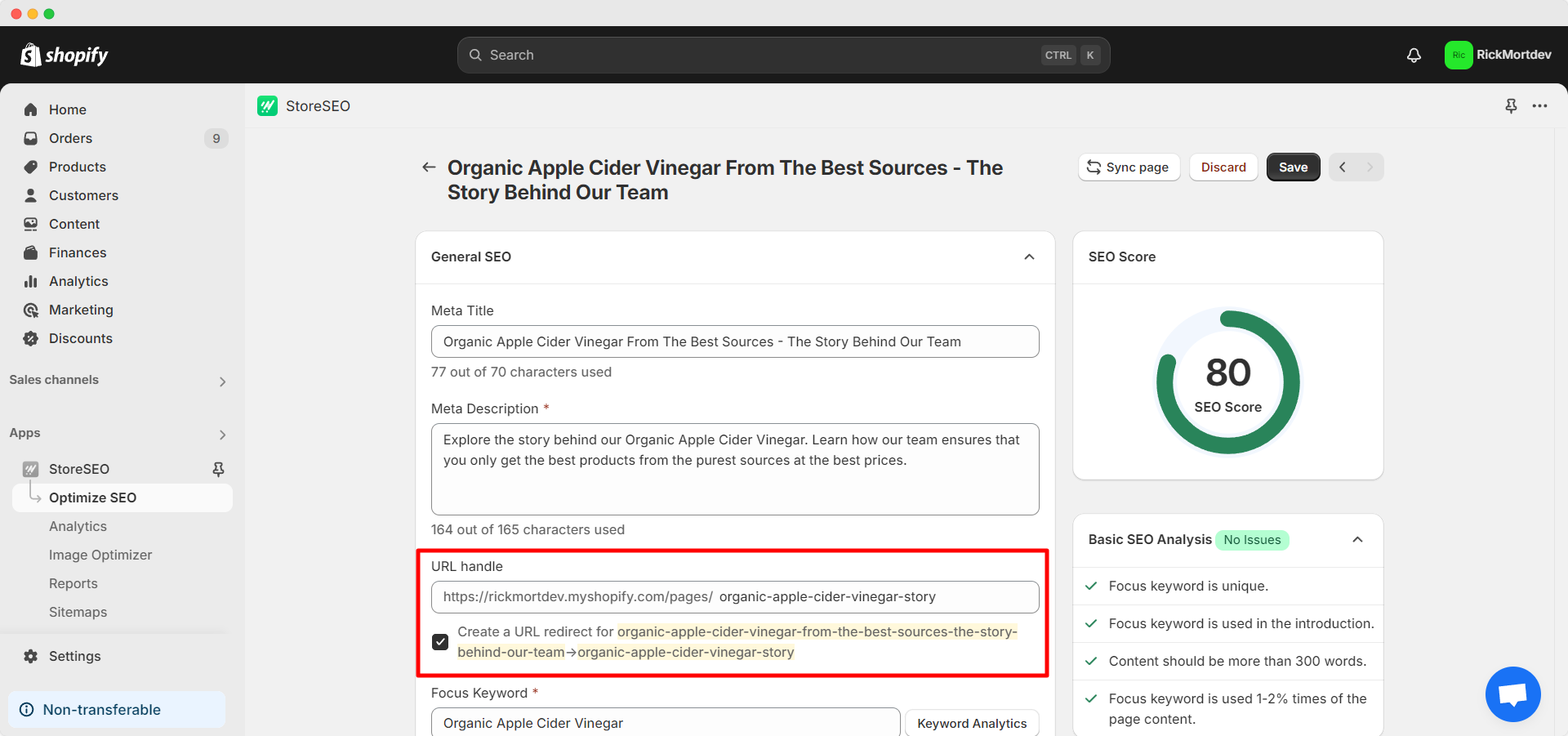
Die Meta-Beschreibung muss maximal 160 Zeichen lang sein. #
Dein Meta-Beschreibung der Seite sollte idealerweise 160 Zeichen lang sein. Wie Sie im Bild unten sehen können, ist unsere Meta-Beschreibung 157 Zeichen lang und erfüllt diese Anforderung.
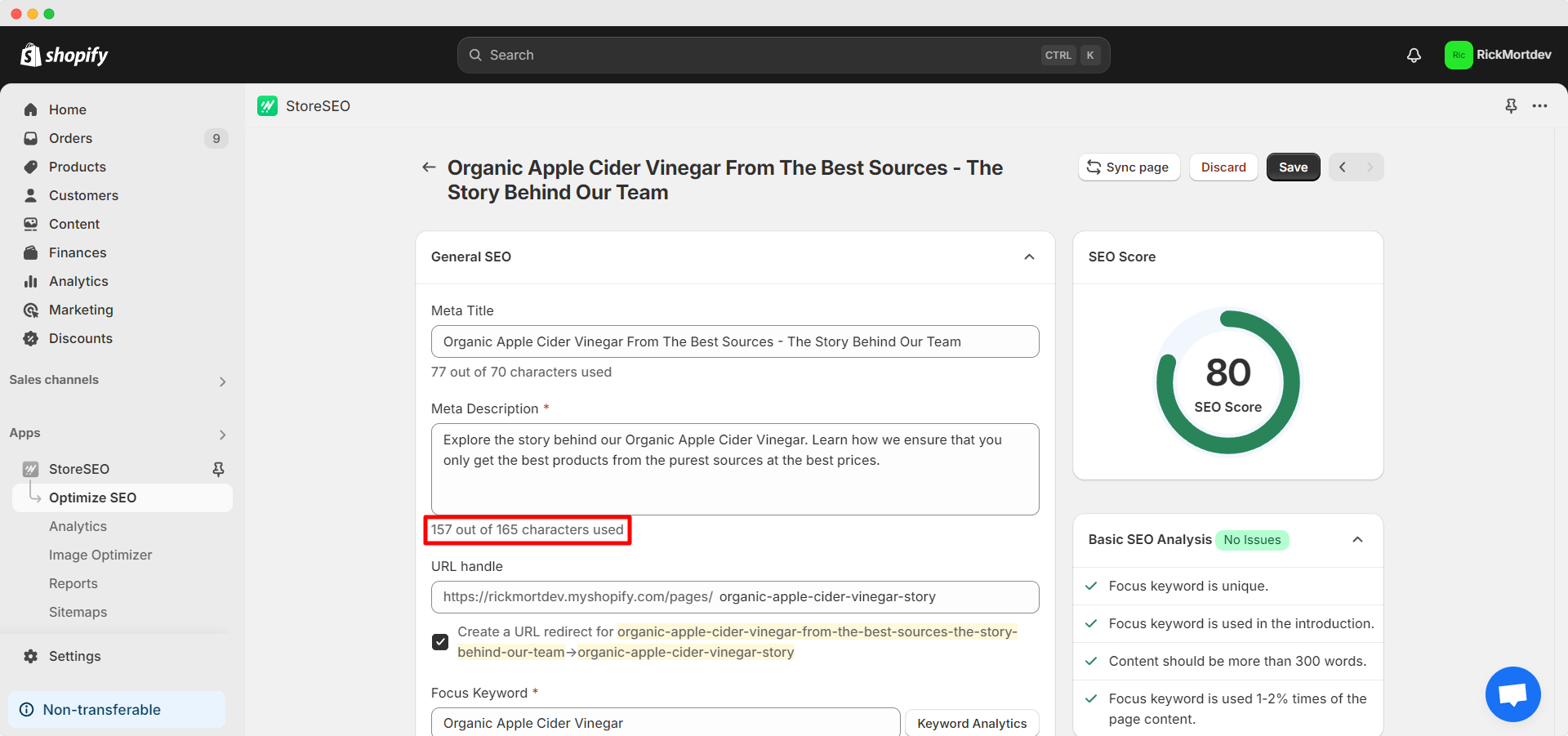
Fokus-Keyword wird im Meta-Titel verwendet #
Stellen Sie sicher, dass Ihr Metatitel das von Ihnen ausgewählte Fokus-Keyword enthält. Wie Sie im Bild unten sehen können, lautet unser Metatitel wie folgt:
Bio-Apfelessig Aus den besten Quellen – Unsere großartige Geschichte
Der Meta-Titel enthält also unser ausgewähltes Fokus-Keyword (fett markiert).
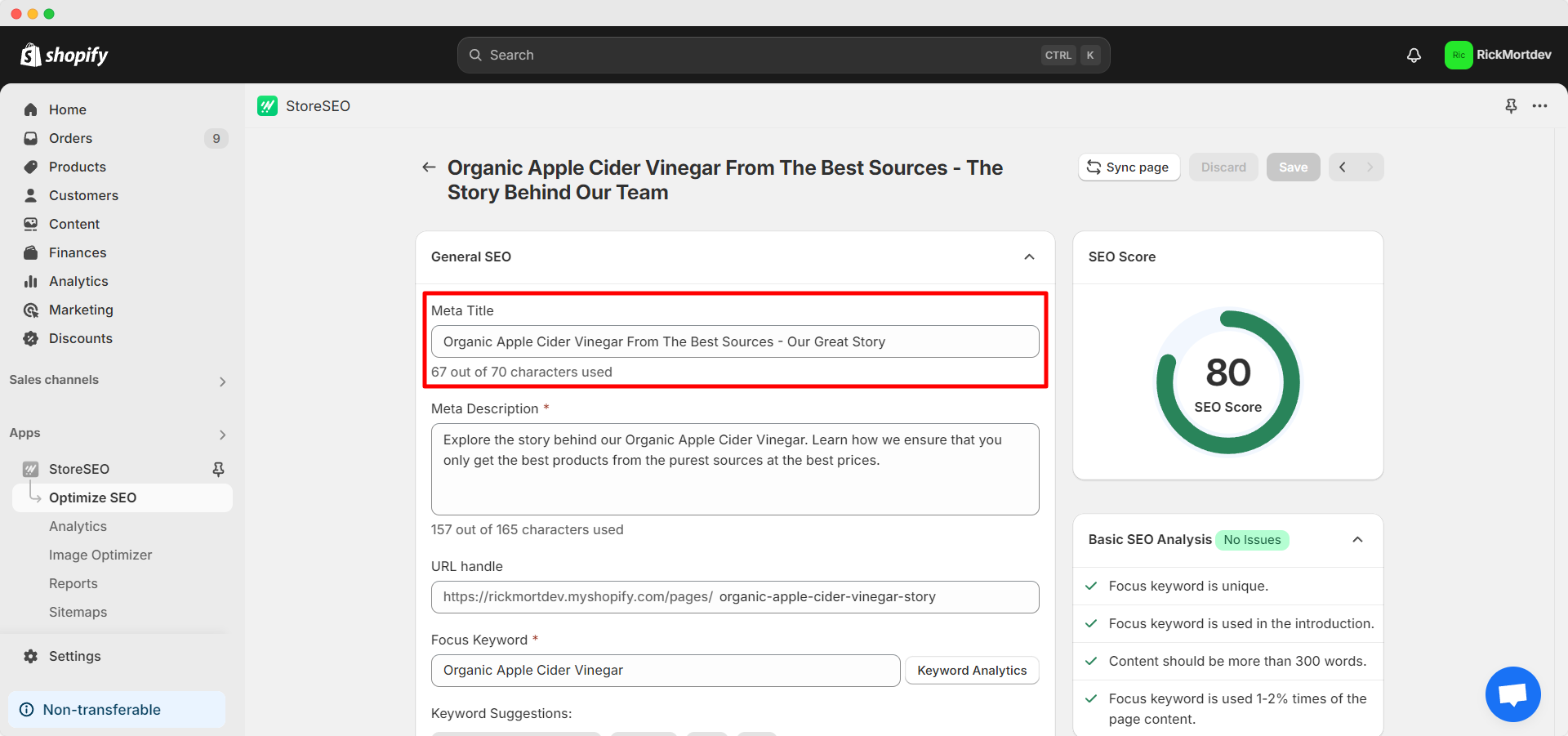
1 interner Link im Seiteninhalt gefunden #
Ihr Seiteninhalt sollte 1 internen Link enthalten. Interner Link bedeutet, dass auf einen anderen Blog, eine andere Seite oder ein anderes Produkt Ihres Shopify-Shops verwiesen wird. Um dies hinzuzufügen, bearbeiten Sie Ihre Seite wie zuvor beschrieben über das Shopify-Dashboard. Wählen Sie die Wörter aus, die Sie als Ankertext festlegen möchten, und klicken Sie auf die Option mit den drei Punkten im „Inhalt'. Wählen Sie als nächstes die 'Link einfügen'. Geben Sie den internen Link in das dafür vorgesehene Feld ein. Sie können auch wählen, ob der Link beim Klicken im selben oder in einem neuen Fenster geöffnet wird. Sie können auch einen Linktitel festlegen. Klicken Sie auf die 'Link einfügen'-Schaltfläche, wenn Sie fertig sind.
Versuchen Sie, auf eine Seite oder einen Blogbeitrag Ihres Shops zu verlinken, der für das Thema oder das auf Ihrer Seite besprochene Produkt oder die Dienstleistung relevant ist. Wie Sie im Bild unten sehen können, haben wir unsere Beispielseite intern mit unserer FAQ-Seite verlinkt.
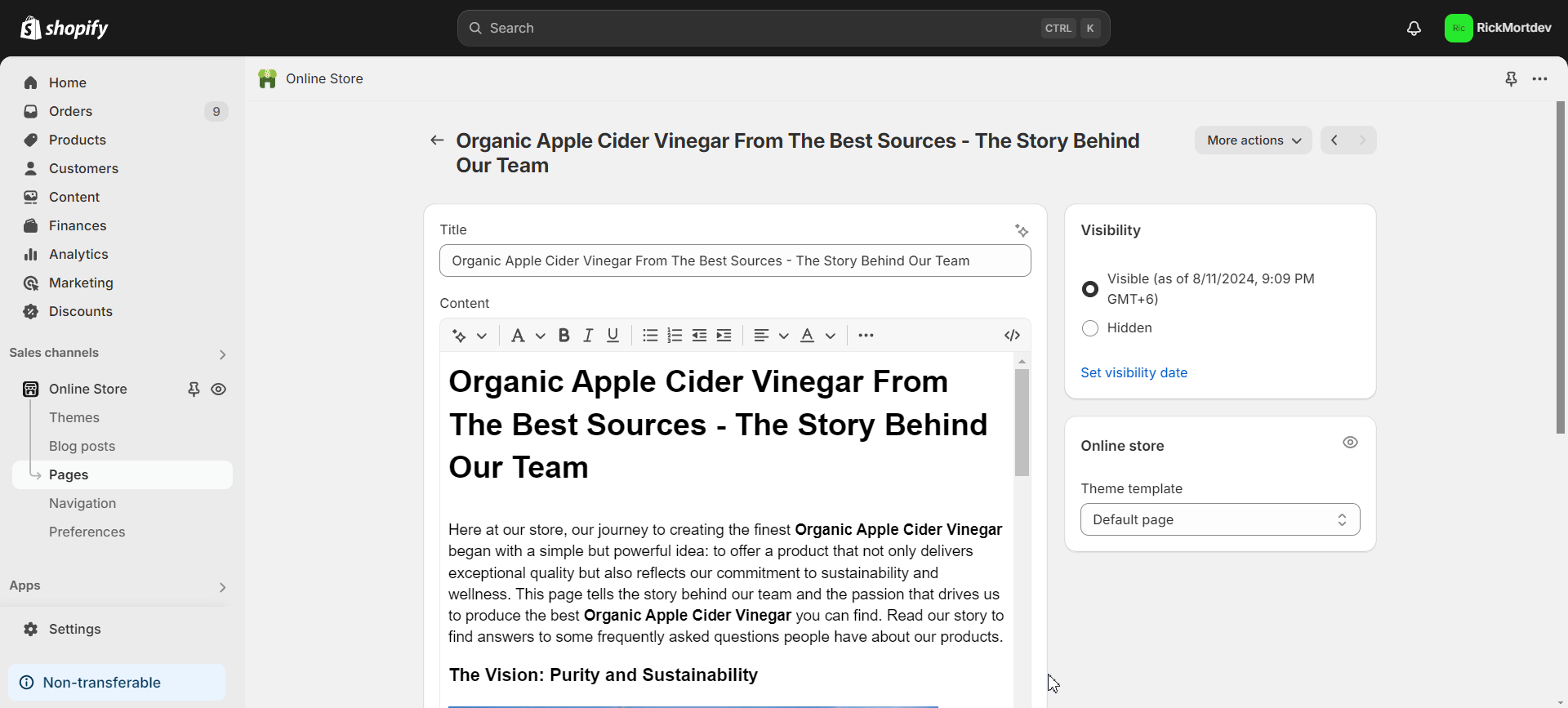
1 externer Link im Seiteninhalt mit Do-Follow gefunden #
Behalten Sie mit Do-Follow einen externen Link im Seiteninhalt. Externer Link bedeutet, auf externe Seiten außerhalb Ihres Shopify-Shops zu verlinken. Fügen Sie ihn beim Bearbeiten Ihrer Seite ein, wie im vorherigen Punkt gezeigt.
Versuchen Sie, auf einen externen Link mit hoher Autorität eines Blogbeitrags oder einer Seite zu verlinken. Außerdem sollte der externe Link für das Thema oder das Produkt oder die Dienstleistung relevant sein, die auf Ihrer Seite besprochen werden. Wie Sie im Bild unten sehen können, haben wir 1 externen Link in unseren Seiteninhalt aufgenommen.
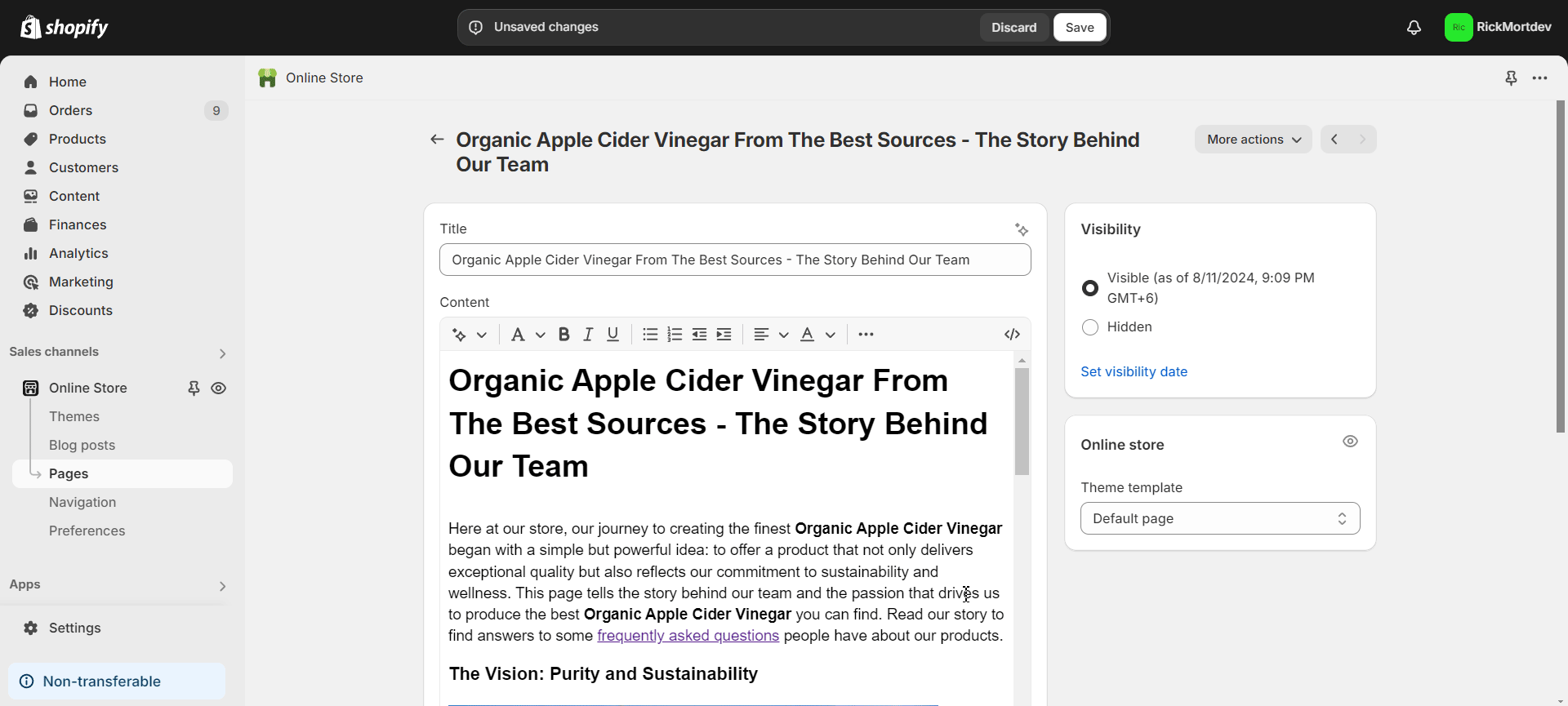
Fügen Sie allen Bildern Alternativtext hinzu #
Wenn Sie mehrere Bilder auf der Seite haben, stellen Sie sicher, dass das Fokus-Schlüsselwort im Alternativtext aller Bilder verwendet wird. Sie müssen dies tun, wenn Sie Ihre Seite vom Shopify-Dashboard aus bearbeiten, wie zuvor beschrieben. Unter dem Punkt „Inhalt' Abschnitt beim Bearbeiten einer Seite, Doppelklicken Sie auf ein beliebiges Bild im Seiteninhalt. Sie können dann den Alternativtext im 'Alternativtext des Bildes' Feld.
Die auf unserer Seite verwendeten Bilder enthalten relevanten Alternativtext, wie im Bild unten gezeigt.
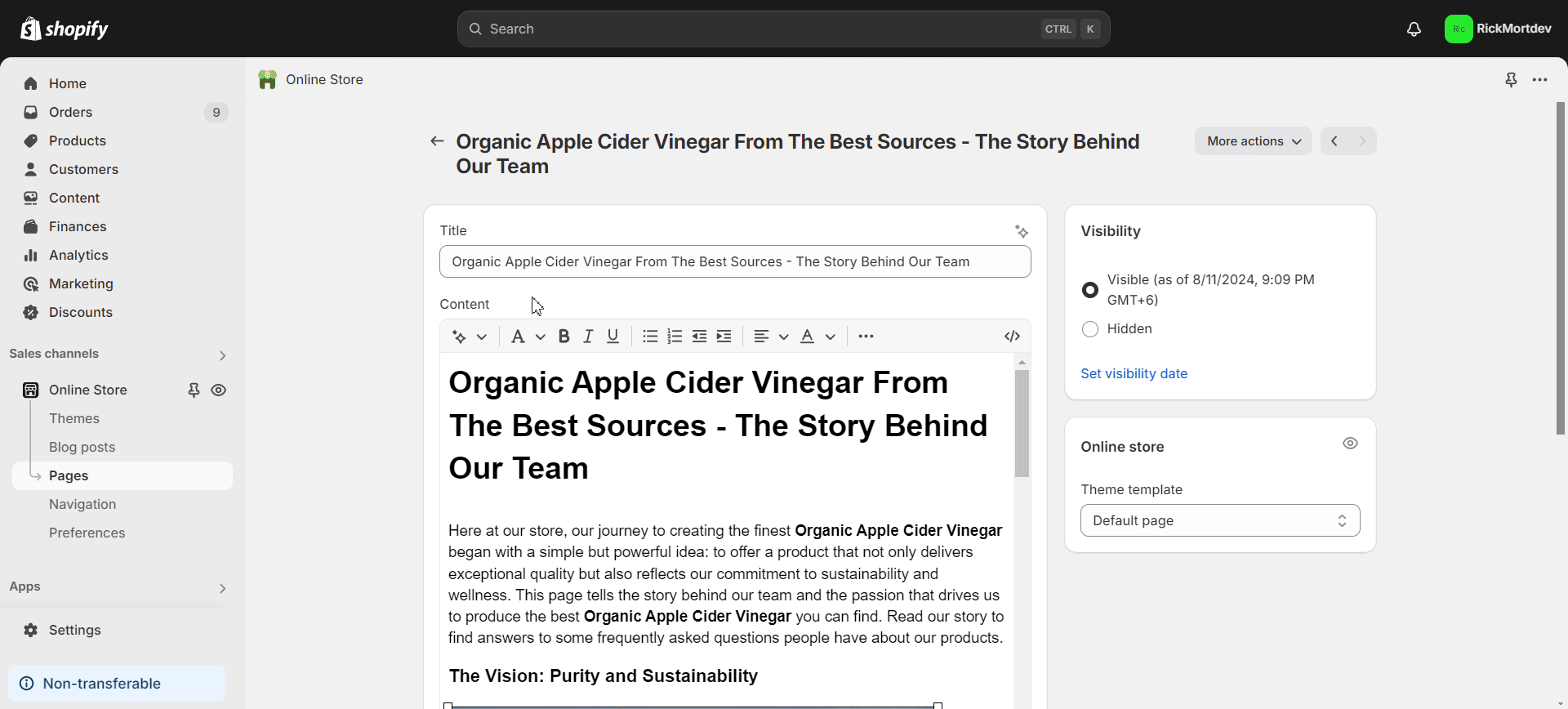
Indem Sie diese Schritte befolgen, können Sie jeden wichtigen SEO-Faktor berücksichtigen, um den bestmöglichen Optimierungswert für Ihre Seite zu erzielen. Wenn Sie Hilfe bei der Optimierung Ihrer Inhalte für SEO mit der Kraft der KI benötigen, können Sie auch die StoreSEO AI Inhaltsoptimierer.
Wenn Sie mit der Seitenoptimierung fertig sind und mit dem SEO-Gesamtergebnis zufrieden sind, klicken Sie auf „Speichern' Taste.
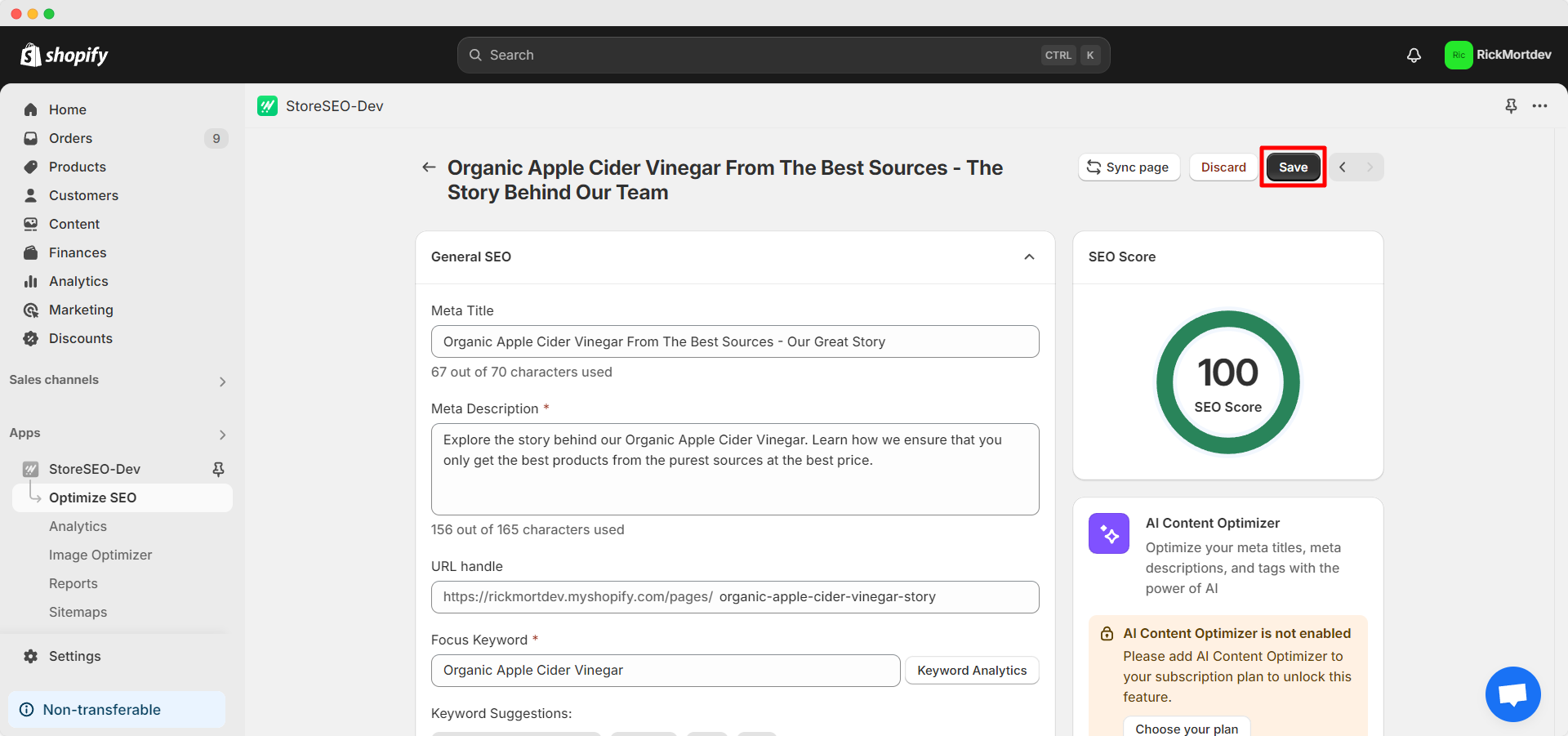
So einfach können Sie Shopify-Seiten optimieren für SEO mit StoreSEO. Brauchen Sie Hilfe? Wenden Sie sich gerne an unseren engagiertes Support-Team für jede Art von Abfrage.



